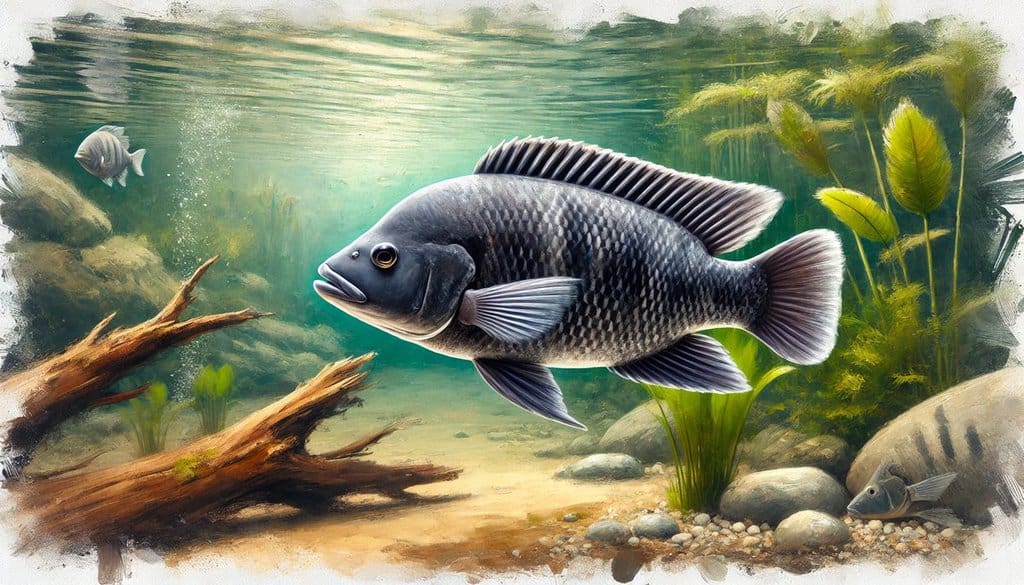Mozambique Tilapia is a popular choice for aquaponics systems due to its hardiness, adaptability, and rapid growth rate[1]. This species is prized for its ability to thrive in various water conditions, making it an excellent option for both novice and experienced aquaponics practitioners[3].
Natural Habitat and Behavior
Origin and native environment: Mozambique Tilapia naturally inhabits slow-moving water bodies such as lagoons, rivers, and impoundments in southern Africa[3].
Natural behavior in the wild: These fish are known for their ability to adapt to various environments, including brackish and saltwater conditions[3].
Temperament: In aquaponics systems, Mozambique Tilapia can be territorial and somewhat aggressive, especially during breeding seasons[4].
Compatibility: Due to their territorial nature, it’s best to keep Mozambique Tilapia with their own species or other hardy fish that can tolerate similar water conditions[4].
Water Requirements
Temperature Range:
- Ideal temperature: 28-36°C (82.4-96.8°F)[1]
- Can survive in temperatures between 16-39°C (60.8-102.2°F)[3]
pH Level:
- Optimal pH: 6-9[1]
- Tolerant of pH fluctuations
Water hardness: Adaptable to various hardness levels, but prefers slightly hard water
Oxygen Levels:
- Optimal: 4-6 mg/L[1]
- Relatively tolerant of low oxygen conditions
Ammonia/Nitrate Sensitivity:
- Ammonia: Less than 2 mg/L
- Nitrites: Less than 5 mg/L [1]
Tank or Pond Setup
Tank/Pond Size Requirements:
- Aquaponics or Recirculating Aquaculture Systems (RAS): 20 kg/m³
- Pond: 1.5 kg/m²
- Cage: 53 kg/m³[1]
Filtration & Aeration: Requires good filtration and aeration, especially in high-density setups
Lighting Considerations: Natural light cycles are sufficient; no special lighting requirements
Tank Decorations/Substrate: Minimal decoration needed; focus on providing adequate space for swimming and territorial behavior
Feeding Requirements
Diet: Omnivorous, but primarily herbivorous as adults[4]
Feeding Techniques:
- Feed 2-3 times daily
- Commercial tilapia feed is recommended for balanced nutrition
- Can supplement with algae and plant matter
Supplements or special diets: Generally not required if using a high-quality commercial tilapia feed
Growth and Reproduction
Growth Rate:
- Can reach 500 grams in 9 months under ideal conditions[1]
- Can grow to over 40 cm (15.7 inches) in length[3]
- Keep male-only tanks for faster growth, as they don’t waste energy on mating.
Physical Growth Indicators: Males typically grow larger than females[3]
Breeding Behavior:
- Mouth brooders
- Can breed year-round in suitable conditions
- Males dig nests and display to attract females[4]
Care of Fry:
- Females incubate eggs in their mouths.
- Fry are released when they can swim freely.
- Provide lots of hiding places or, better yet, separate rearing tanks for better survival rates.
Harvesting & Culinary Considerations
Growth to Harvest:
- Typically harvested at 400-500 grams (14-17.6 oz)
- Takes about 6-9 months to reach harvest size[1]
Culinary Uses: Mild-flavored white fish, suitable for various cooking methods
Recommendations for Ethical Harvesting: Quick and humane methods such as ice slurry immersion are recommended
Pros and Cons in Aquaponics Systems
- Hardy and adaptable
- Fast growth rate
- Efficient feed conversion ratio (FCR) of 1:1.4[1]
- Tolerant of various water conditions
- Can be aggressive and territorial
- May require separate breeding tanks for optimal reproduction
- Potential for overpopulation if breeding is not controlled
Overall Suitability: Excellent for beginners and experienced aquaponics practitioners, especially those focused on food production
Common Health Issues and Solutions
Potential Diseases: Susceptible to common fish diseases like ich and fin rot
Signs of Health Issues: Lethargy, loss of appetite, abnormal swimming behavior
Treatment Recommendations: Maintain water quality, quarantine affected fish, and use appropriate treatments as needed
Maintenance Tips for Long-Term Health
Maintenance Frequency: Regular water quality checks and system maintenance
System checks: Monitor temperature, pH, ammonia, and nitrite levels regularly
Handling Practices: Minimize handling to reduce stress
Winter/Summer Care: Ensure stable temperatures, especially in outdoor systems
Tank Compatibility and Stocking: Maintain appropriate stocking densities to prevent overcrowding. Can be aggressive, especially when breeding.
Closing Thoughts
Due to its hardiness, adaptability, and fast growth rate, Mozambique Tilapia is an excellent choice for aquaponics systems. While they require attention to water quality and can be somewhat aggressive, their ability to thrive in various conditions makes them a popular option for both novice and experienced aquaponics practitioners.
More fish species for aquaponics
External sources:
[1] https://www.dffe.gov.za/sites/default/files/reports/feasibilitystudy_nileandmozanbiquetilapia.pdf
[2] https://cales.arizona.edu/azaqua/ista/ISTA8/ANNAL.pdf
[3] https://pestsmart.org.au/toolkit-resource/biology-and-ecology-of-mozambique-tilapia-oreochromis-mossambicus/
[4] https://sta.uwi.edu/fst/lifesciences/sites/default/files/lifesciences/documents/ogatt/Oreochromis_mossambicus%20-%20Mozambique%20Tilapia.pdf
[5] https://gogreenaquaponics.com/blogs/news/how-to-raise-tilapia-in-aquaponics

